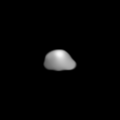22 Kalliope facts for kids
| Discovery | |
|---|---|
| Discovered by | John Russell Hind |
| Discovery date | November 16, 1852 |
| Designations | |
| none | |
| Main belt | |
| Orbital characteristics | |
| Epoch November 12, 2005 (JD 2453686.5) | |
| Aphelion | 479.931 Gm (3.208 AU) |
| Perihelion | 390.433 Gm (2.610 AU) |
| 435.182 Gm (2.909 AU) | |
| Eccentricity | 0.103 |
| 1812.245 d (4.96 a) | |
|
Average orbital speed
|
17.42 km/s |
| 303.545° | |
| Inclination | 13.710° |
| 66.240° | |
| 356.172° | |
| Physical characteristics | |
| Dimensions | 215×180×150 km |
| Mass | 6.3 ± 0.5 ×1018 kg |
|
Mean density
|
2.03 ± 0.16 g/cm³ |
| 0.038 m/s² | |
| 0.09 km/s | |
| 0.1728 d (4.148 h) | |
| Albedo | 0.142 |
| Temperature | ~161 K max: 240 K (-32°C) |
|
Spectral type
|
M |
| 6.45 | |
22 Kalliope is a large asteroid that travels around the Sun in the main asteroid belt. It is an M-type asteroid. A scientist named J. R. Hind discovered it on November 16, 1852. The asteroid is named after Calliope, who was the Greek goddess of epic poetry.
What is 22 Kalliope Like?
Kalliope is about 180 kilometers (112 miles) wide. It is not perfectly round. Pictures from the VLT at the European Southern Observatory show its uneven shape.
Even though it is an M-type asteroid, Kalliope does not seem to be made of metal. Its density is too low for it to be metallic. Also, studies have found signs of water-containing minerals and silicates on its surface. This means its surface is likely stony, not metallic. Kalliope also reflects radar waves poorly, which is different from most metallic surfaces.
Scientists have studied how Kalliope's brightness changes as it spins. This helped them figure out its pole points towards certain ecliptic coordinates. This gives Kalliope an axial tilt of about 103 degrees. This means Kalliope's rotation is a bit retrograde, or backward, compared to most objects in the Solar System.
Kalliope's Moon: Linus
Kalliope has one moon that we know about. It is called Linus, or (22) Kalliope I Linus. Linus is quite big for a moon of an asteroid, measuring about 30 to 40 kilometers (19 to 25 miles) across.
Linus orbits Kalliope at a distance of about 1065 kilometers (662 miles). This distance is about 12 times the radius of Kalliope itself. Jean-Luc Margot and Michael E. Brown discovered Linus on August 29, 2001. Another group of scientists also found the moon just three days later.
Images for kids
See also
 In Spanish: (22) Kalliope para niños
In Spanish: (22) Kalliope para niños


